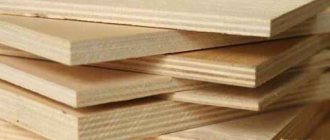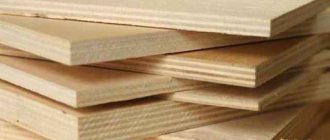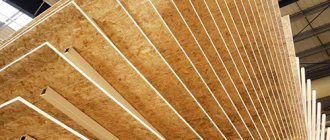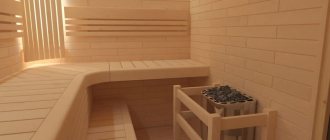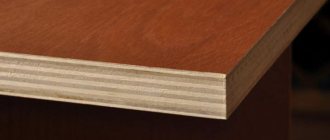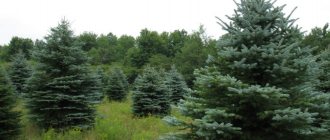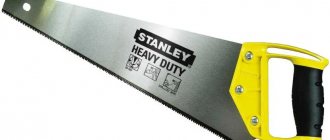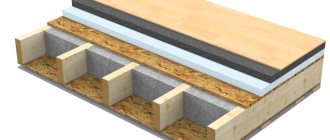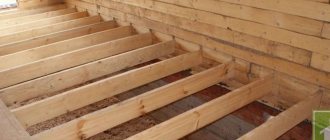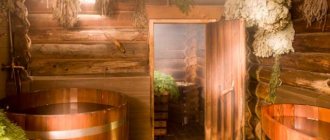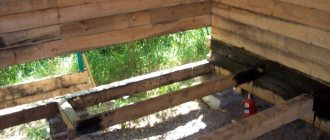How to choose plywood for construction work
In terms of its consumer properties, plywood may be preferable to solid lumber. Since it is glued together from several intersecting layers of veneer, the sheet is stronger than ordinary boards of the same thickness. Some brands of plywood have higher moisture resistance and wear resistance. Due to the large size of the slabs, plywood is convenient for creating all kinds of load-bearing flooring, as well as rough and finishing sheathing. In terms of scope of use, this material has only one competitor - OSB.
This article will tell you how to choose plywood for a construction site.
Using plywood for flooring “+” and “-”
Advantages of plywood:
- plywood, unlike OSB and fiberboard, is a natural material and not recycled production waste. Therefore, it is more environmentally friendly;
- plywood moisture levels are in the range of 12-15%;
- plywood takes the brunt of variable loads. Thus, the screed retains its integrity, and the wood receives microcracks. However, they do not affect the quality of the floor;
- Due to the fact that plywood is made from wood, it has better contact with floor coverings. As a result, the service life of the latter increases;
- plywood makes it possible to obtain a floor that will meet the specified characteristics (flatness, surface quality) with less time and resources;
- laying plywood on the floor does not require special preparation and can be performed in several stages;
- plywood plays the role of a kind of insulation, allowing to reduce heat loss through the concrete screed and floor slabs;
- If there is a significant difference in height across the floor, the use of a screed is not recommended due to its high weight and cost. But plywood, on the contrary, would be an ideal option;
- Depending on the grade and quality of polishing, plywood can be used for rough and finished flooring.
But:
- plywood is not suitable for rooms with a significant temperature difference (for example, for dachas or houses of non-permanent residence), as well as with a high level of humidity (in a bathroom, bathhouse, sauna, swimming pool).
What species is the veneer for plywood made from?
It should be noted that coniferous or hardwood plywood is called by the type of species its outer layers are made of. That is, the veneer on top can be made from deciduous veneer of birch, linden, poplar, alder... and inside it is possible to use pine needles (pine, spruce, cedar... veneer). Slabs that contain different rocks are called combined.
Based on multiple tests, birch plywood is approximately twenty percent stronger than a homogeneous product glued together from pine/spruce veneer. And it will be almost twice as much as aspen slabs.
Such results are largely explained by the increased density of birch plywood compared to coniferous products. In numbers, we have an average of 700 kg/m3 versus 560 kg/m3, respectively. High density is not only good resistance to bending and stretching. This is also wear resistance, the ability to reliably hold loaded fasteners, etc.
But not all hardwood plywood is created equal; for example, a Chinese product made from poplar has a density of about 500 kg/m3. And sometimes the density drops to 350-400 kilograms per cubic meter. Moreover, even more problems with such sheets are related to environmental safety, since they usually contain many times more harmful substances than the maximum concentration established by regulations. Poplar is softer than birch and is more afraid of water.
Considering its low cost, Chinese poplar plywood (for example, laminated FOF) has a right to exist; it will more than earn its money when creating formwork panels or assembling flooring for scaffolding.
Variety of plywood
Softwood boards are described in GOST 3916.2-96 “General purpose plywood with outer layers of softwood veneer. Technical conditions".
Hardwood boards are described in GOST 3916.1-96 “General purpose plywood with outer layers of hardwood veneer. Technical conditions".
Structure and types of plywood
Plywood is always a multi-layer material made from natural wood veneer. During its production, the veneer layers are positioned perpendicular to each other and glued together under pressure. Usually an odd number of layers is used, at least three. Therefore, this material is often called three-layer, five-layer or multi-layer plywood.
Plywood can be classified according to different characteristics. For example, according to the species taken for making wood, there is a difference between coniferous and hardwood plywood for the floor in a wooden house. For outer layers of plywood, veneer is obtained from:
- ate;
- pine trees;
- larches;
- fir;
- cedar pine.
The inner layers are often made from hardwood. There is also pure birch plywood, which costs slightly more than coniferous plywood, so it is less often used in construction for leveling floors.
Plywood can be classified according to its resistance to moisture, which makes it resistant to different impregnations to varying degrees:
FC is a material in which veneer is glued together with urea glue. This plywood has low moisture resistance, so it is only suitable for the production of furniture or interior decoration. FC is available in the following thicknesses: from 3 to 10 mm, then 12, 15, 18 and 21 mm. It is usually produced in square sheets with a side of 1525 mm, the density of which is 640-700 kg/m3, and the humidity is up to 10%.- FSF - here the veneer is glued together with phenolic resins, which give the material moisture resistance. In addition, it is mechanically strong and wear-resistant, so it is a common solution to the question of which plywood is best for the floor. FSF can be used not only for interior decoration, but also for exterior decoration, for example, along joists when laying a roof. This plywood has a lot of thickness options, ranging from 6 mm to 40 mm. Its sheets can be the same size as the already described squares or rectangles 1220 (1250) x 2440 (2500) mm, with a nominal humidity of the same 10% and the same density.
- BS, FB, FBS plywood options are glued with varnish or bakelite glue. This is the most durable and moisture-resistant plywood, capable of working even in extreme conditions, which is why it is used in shipbuilding and aircraft manufacturing. The thickness of these brands of plywood is in the range of 5-18 mm. Its sheets are produced very large - 1550 x 5300 (5600) mm, with a nominal humidity of 10%, but with a higher density - 1200 kg/m3.
- BV is a material impregnated with water-based bakelite glue. It has technical characteristics similar to the previous ones, but it does not have the same moisture resistance - water spilled under the laminate on a wooden floor dissolves the glue, and the plywood loses its properties.
- FOF is plywood, the surface of which is laminated with a film, and the veneer is impregnated with synthetic resin. How thick should FOF plywood be - from 3 mm to 40 mm, and the size of its sheets is approximately the same - 1220 (1250) x 2440 (2500) mm at normal density.
What does the grade of plywood mean?
Labeling is the most important information for selection. The abbreviation letters usually tell us what type of binder was used to glue and impregnate the veneer. The characteristics of the binder have an even greater influence on the overall performance of the board than the type or species of wood used.
In general, in the first and second parts of GOST 3916, only two brands are distinguished:
- FSF
- FC
This plywood, along with laminated FOF models, is mainly presented in domestic retail outlets.
FK brand material is glued together with urea binders. Plates of this type have good strength and excellent appearance. They are absolutely safe. Contrary to popular belief, FC plywood is moisture resistant, but only moderately, so it is preferable to use it indoors.
Deciduous and coniferous FSF sheets are collected using phenol-formaldehyde resins. They are positioned as HIGH MOISTURE RESISTANCE plywood, which can be used indoors and outdoors or in rooms with high humidity. That is, this is, in fact, the only option for cladding the walls of a house from the outside, for assembling a continuous deck on the roof, for creating ceilings and partitions in frame houses, which during construction can be exposed to precipitation for a long time.
Factory marking of plywood pallets
FOF laminated plywood is a type of veneered plywood. In this case, the base is a slab glued using phenol-formaldehyde binder. The outer layer here is sanded and protected with a paper film impregnated with synthetic glue. The cladding can be on only one side or on both; it can be smooth or with a relief mesh structure. Often, FOF plywood has additional paint protection applied to the edges. A dense and durable film acts as the main barrier to moisture and significantly increases the wear resistance of surfaces, which is why laminated plywood models are so often used as reusable formwork. It is also used to assemble used technical decks, truck vans, street furniture, etc.
Plywood for flooring - protection, operation and storage
In order for a plywood floor to serve you faithfully for a long time, you need to provide protection for the sheets at the installation stage. When working with plywood you need to consider:
- plywood needs acclimatization .
Only the purchased material should not be used immediately. It needs to be given time to rest in the conditions in which it will be used. The holding period depends on where, how, in what position, at what temperature and humidity level the plywood was stored. The acclimatization period can be:
- day. If the difference in temperature and humidity at the place of sale and installation is minimal, and the sheets were stored in a dry room, on a flat surface in a horizontal position;
- 3-5 days. If the difference exceeds 5-8°C and 10% (temperature and humidity, respectively);
- over a week. If the deviations are significant or the sheets are slightly deformed. The latter can be eliminated by pressing down the stack of sheets with weights and using more hardware per 1 square meter. leaf.
- dampness destroys plywood . Rapid fluctuations in humidity can cause serious damage to the wood from which plywood is made. At the same time, constant humidity in the room cannot be higher than 70%, and short-term - 80%. Laying plywood on a wet base is unacceptable. To check the moisture level of a wooden base, use a special device. And concrete is covered with film for a day. The presence of condensation under the film indicates that it is worth holding off on installing the plywood;
- plywood sheets are laid at a temperature of 20-30°C . In this case, the leaf is in optimal conditions;
- additional processing improves the performance characteristics of plywood . For example, an antibacterial primer will protect the sheet from the effects of fungi and microorganisms. Impregnation with PVA-based putty will increase its moisture resistance. And applying acrylic varnish will increase the strength of the surface layer.
Prices for FC 4/4 plywood
| Product name | The price of the product |
| Plywood 4 mm birch FC grade 4/4 1525x1525 mm | RUB 500.00 |
| Plywood 6 mm birch FC grade 4/4 1525x1525 mm | RUB 850.00 |
| Plywood 8 mm birch FC grade 4/4 1525x1525 mm | RUB 900.00 |
| Plywood 9 mm birch FC grade 4/4 1525x1525 mm | RUB 1,100.00 |
| Plywood 10 mm birch FK grade 4/4 1525x1525 mm | RUB 1,010.00 |
| Plywood 12 mm birch FK grade 4/4 1525x1525 mm | RUB 1,150.00 |
| Plywood 15 mm birch FK grade 4/4 1525x1525 mm | RUB 1,450.00 |
| Plywood 18 mm birch FC grade 4/4 1525x1525 mm | RUB 1,550.00 |
| Plywood 21 mm birch FC grade 4/4 1525x1525 mm | RUB 2,050.00 |
Division by variety
Types of plywood.
Plywood sheets are divided by grade. There are 5 types of key material in total. The highest grade is indexed with the letter E (elite). Poor quality veneer is marked with the Roman numeral IV. Products are sorted as follows:
- veneer, indicated by the number IV, may have all possible defects - from knots to surface irregularities; the manufacturer can only guarantee high-quality gluing of the layers;
- grade III is used for the manufacture of hidden structures;
- grade II allows some defects on the surface, but they can be easily eliminated with coating materials without additional processing;
- on first grade plywood there may be single knots, the diameter of which does not exceed 8 mm, and small dark veins;
- a surface devoid of visible defects, knots, veins and wormholes distinguishes grade E plywood.
The grade of plywood is marked not by one number or letter, but by a combination of them, depending on the condition of its front and back veneer. There is no material with the E/E combination, but the rest of the markings look like this: E/I, I/I, I/II, II/II, II/III, II/IV, III/III, III/IV, IV/IV . Instead of numbers, varieties can be marked with Latin letters A, B, C (E/A, etc.).
Prices for FC 3/4 plywood
| Product name | The price of the product |
| Plywood 4 mm birch FC grade 3/4 1525x1525 mm | RUB 750.00 |
| Plywood 6 mm birch FC grade 3/4 1525x1525 mm | RUB 910.00 |
| Plywood 8 mm birch FC grade 3/4 1525x1525 mm | RUB 1,130.00 |
| Plywood 9 mm birch FC grade 3/4 1525x1525 mm | RUB 1,380.00 |
| Plywood 10 mm birch FK grade 3/4 1525x1525 mm | RUB 1,450.00 |
| Plywood 12 mm birch FC grade 3/4 1525x1525 m | RUB 1,550.00 |
| Plywood 15 mm birch FK grade 3/4 1525x1525 mm | RUB 2,000.00 |
| Plywood 18 mm birch FK grade 3/4 1525x1525 mm | RUB 2,350.00 |
| Plywood 21 mm birch FK grade 3/4 1525x1525 mm | RUB 2,730.00 |
Application
FSF birch plywood, as a denser, stronger and more durable material, is most in demand in large-scale construction, mechanical engineering, and carriage building. Very often it is used in the construction of billboards, in the production of boxes and other packaging containers, in the construction of “temporary buildings”, garden houses, change houses, and in the external decoration of buildings.
Application of plywood in construction
FCs are successfully used in interior decoration, flooring, creating partitions, etc. Also, environmentally friendly and beautiful furniture made from birch plywood is very popular: for a summer house, a country house, a children’s room, especially since you can make it yourself.
FSF coniferous plywood, due to its low cost, has found application in shipbuilding (formwork of boats, boats, yachts), in the automotive industry (sub-floors, trailer trim) and in areas of construction where there are no strict requirements for strength and large loads on the structure.
FC is not as durable as birch, but, thanks to its beautiful texture and moisture resistance, it is also in great demand in furniture production, and especially in the decorative design of premises. It is successfully used in small and private construction, for example, as a base for parquet/laminate flooring, or for flexible roofing tiles.
Plywood furniture
To summarize, we note that both materials are worthy of being used in any idea, but if you need something beautiful, pleasing to the soul and not very expensive, then this is pine needles. Birch, as a more durable and expensive material, will serve you for many years and is best suited for large-scale and complex construction projects.
Did the article help you? ( 19 ratings, average: 4.16 out of 5)
Prices for FSF 4/4 plywood
| Product name | The price of the product |
| Plywood 6 mm birch FSF grade 4/4 1220x2440 mm | RUB 1,600.00 |
| Plywood 9 mm birch FSF grade 4/4 1220x2440 mm | RUB 2,150.00 |
| Plywood 12 mm birch FSF grade 4/4 1220x2440 mm | RUB 2,700.00 |
| Plywood 15 mm birch FSF grade 4/4 1220x2440 mm | RUB 3,100.00 |
| Plywood 18 mm birch FSF grade 4/4 1220x2440 mm | RUB 3,500.00 |
| Plywood 21 mm birch FSF grade 4/4 1220x2440 mm | RUB 4,500.00 |
Which is better
Comparison of the pattern of pine and birch plywood.
Coniferous has a pronounced texture. So, we looked at the main characteristics and made sure that this building material has practically no disadvantages, but only advantages. This raises the question: which plywood is better: birch or coniferous? The answer is that it all depends on where and how you intend to use it to make the most of those benefits.
Prices for FOF plywood (laminated) 1500x3000 mm
| Product name | The price of the product |
| Plywood 4 mm laminated FOF 1500x3000 mm | RUB 1,900.00 |
| Plywood 9 mm laminated FOF 1500x3000 mm | RUB 5,300.00 |
| Plywood 12 mm laminated FOF 1500x3000 mm | RUB 3,500.00 |
| Plywood 15 mm laminated FOF 1500x3000 mm | RUR 6,700.00 |
| Plywood 18 mm laminated FOF 1500x3000 mm | RUB 8,000.00 |
| Plywood 21 mm laminated FOF 1500x3000 mm | RUB 8,700.00 |
There are a number of brands of plywood that differ in additional properties (FBA, FB, BS, BV, FSK, FKM...), but they are not particularly widespread in the construction industry.
Advantages
Plywood is considered one of the most convenient and practical materials for leveling the floor.
It is known that plywood is a wood processing product, so it has the same basic properties as wooden products, while plywood has a number of advantages over wood due to its structure. For example, thinner than boards, sheets of this building material have the same resistance to mechanical loads as the latest ones. It turns out that a lighter plywood structure can be no less rigid and elastic than a wooden one. In addition, veneer material can provide an absolutely flat surface, which makes it one of the most successful choices when arranging durable ceilings, walls and floors; in addition, plywood can be used to create a reliable base for different types of roofing. However, the main task here is to determine which plywood is best suited for the floor.
It’s worth saying right away that plywood, although inferior (and not always) to some related products in a number of indicators, has one main advantage - high environmental friendliness. And its properties are directly related to the brand, manufacturing technology and grade. It should be noted that the domestic industry produces quite high-quality products that are noticeably superior to Chinese samples, whose manufacturers strive to use cheap binders and defective veneers in their production. It is often very difficult to determine whether the outer layers of products from China have been sanded.
Which plywood is safe to use in a room?
For a long time, FC plywood was considered the most environmentally friendly compared to other brands, since it practically did not emit harmful substances into the air. Now it has not become any worse, but in terms of formaldehyde emissions into the air, FSF plywood has noticeably improved. It deservedly receives documents confirming the E1 emission class, and such material is allowed for use in medical institutions and children's rooms. Formally, class E1 includes plywood boards with emissions of up to 8 mg per 100 grams of material. And for class E2 - from 0.8 to 30 mg of formaldehyde per 100 grams of dry board.
Almost all laminated plywood in Moscow corresponds to the E1 emission class, but this usually does not apply to Chinese-made boards. In any case, it is advisable to verify the safety of any plywood based on domestic certificates.
Types of plywood
Plywood is divided into types based on its scope of application: construction, furniture, structural, industrial, packaging.
The type of plywood is determined based on the glue used during production:
- FC is a water-repellent type of plywood. Its sheets are glued together using urea glue;
- FSF is plywood with enhanced water-repellent properties. In this case, the layers are glued with phenol-formaldehyde glue;
- FBA is ordinary plywood, the sheets of which are glued with albumin casein glue. Such plywood is afraid of moisture, but it is chosen because of its harmlessness to humans;
- FB is plywood created for use in particularly wet conditions, even in water. Such qualities are acquired by the material due to its impregnation with bakelite varnish.
Listed above are only the most famous types of plywood. There are additional classifications depending on the thickness, wood used, and surface quality.
What type of plywood is better to buy
If the brand indicates water resistance and wear resistance, then the grade reflects exclusively the APPEARANCE of the plywood sheet. The physical and chemical characteristics of all grades of FK and FSF plywood remain unchanged and are standardized by current standards.
The determining criteria are visible processing defects and defects in the wood of the slab. In total, 28-30 indicators are taken into account, among which it is necessary to highlight:
- bitches
- cracks,
- Sorry,
- Tars and pockets,
- Rot,
- Foreign colors,
- Edge defects
- Warping,
- bundles,
- Roughness,
- Leaked glue
- Repair inserts.
Defects and flaws are allowed inside the plywood board in addition to the list of 28 or 30 items, but if they do not affect the performance properties or appearance of the board.
Depending on the presence and number of defects, FK/FSF plywood is divided into 5 categories:
- E is an elite type, it has almost no drawbacks (except for “eyes” and roughness), and is used mainly for finishing with a transparent protective and decorative coating.
- I – has single knots and small local color changes.
- II – almost the same defects are allowed as in the first grade, but in slightly larger quantities. All of them can be eliminated by tinting varnish or painting.
- III – in addition to knots, it may contain wormholes and cracks. Well suited for creating closed load-bearing structures and for rough cladding.
- IV – may contain all possible defects, but in limited quantities for some of the items. Mainly used as an inexpensive auxiliary material, for example, if you need to make disposable formwork.
Note that for each grade, GOSTs indicate the maximum number of defects from the list. For 1st grade – 6, for 2nd grade – 9, for 3rd grade – 12, for 4th grade – unlimited. Elite plywood (E) should not have visible defects.
Different sides of a plywood sheet can correspond to different grades. Therefore, the marking is always double: E/1, E/2, E/3, 1/2, 1/3, E/E, 2/2, 3/3, 3/4, 2/3, etc. The obverse side is considered to be the one with a higher grade.
In addition to the domestic digital marking of the grade, sometimes foreign designations can be found on the slab: B (S), BB, CP, C - from the first to the fourth grade, respectively.
Laying plywood on the floor
4.1 Plywood for subfloor
Laying a plywood subfloor is the fastest, most affordable and easiest way, which also has several varieties.
Laying plywood on a concrete screed Laying plywood on a concrete screed . Sheet 10-12 mm thick. glued to the base. It is used when there is a smooth concrete screed of normal quality. The main thing is not to forget about expansion joints when laying. The gap is 3-4 mm. between the sheets, as well as between the sheet and the wall, will allow the plywood to play and adapt to its surrounding conditions.
Adjustable plywood floors This installation method can be used when there is a difference in height. It is enough to use special fasteners.
Adjustable plywood floors do not require the installation of joists, and height differences are leveled by fasteners located under the plywood.
Material prepared for the website www.moydomik.net
Installation of plywood on joists or floor beams. Installation of plywood on joists or floor beams .
Plywood, thickness over 12 mm. mounted on a prepared base. The method is labor-intensive, usually used when it is necessary to insulate the floor or raise it to a certain height.
Adjustable joists Adjustable joists allow you to install a sheet of plywood so that it can compensate for differences in height across the floor.
4.2 Leveling the floor with plywood
Leveling the floor with plywood A fairly common situation is when the floorboards have partially lost their appearance, but nevertheless do not cause any complaints. Then the flooring is laid on top of them.
But to prevent the finishing coating from becoming unusable, an intermediate floor (in this case, plywood) should be laid on the boards, which will level the surface.
Laying plywood on a wooden floor is carried out using hardware and is characterized by simplicity and high speed of work.
In order for plywood laid under laminate, linoleum or parquet boards to perform its functions for a long period, you must adhere to the following installation rules:
- securely fasten all sheets taking into account deformation gaps;
- “drown” the heads of the hardware into the sheet;
- remove irregularities using a grinder;
- fill in depressions and cracks;
- lay the substrate.
But laying plywood under a wooden floor is absolutely not required. Due to the massiveness of the floorboard, it can be laid on joists or on a flat concrete screed.
4.3 Finish plywood floor
Craftsmen can create real palace parquet from plywood. In this case, special requirements are put forward for the quality of plywood. Only the first grade can be used; the surface of the front side of the sheet must be polished. To create a beautiful pattern, the plywood is treated with stain, and the laid plywood parquet is sanded and covered with several layers of parquet varnish.
Pattern on plywood floor
Plywood parquet
Plywood floor covered with stain
Does plywood need a sanded surface?
Surface grinding allows you to achieve better aesthetics. Plywood Ш1 (processed on one side) and Ш2 (processed on 2 sides) are chosen when high-grade sheet material is needed for finishing and will be opened with transparent impregnation/varnish.
For roughing work, you can use slabs with unpolished outer layers of veneer (NS). In some cases, when something will be glued on top of the plywood flooring, a rougher surface is preferable, as it provides better adhesion.
Plywood for walls
Film laminated plywood
Permissible defects in plywood
Features of OSB
Despite some visual similarities between plywood and OSB boards, these are completely different materials with different properties.
The main competition for plywood is oriented strand boards, which can be called its successors, since they have a multilayer structure, and each layer is oriented perpendicular to the neighboring one. Non-professionals often call OSB plywood, although in addition to some similarities, these materials have a number of significant differences. They are made by hot pressing not veneer, but thin shavings that are bonded together with synthetic fibers, resins and paraffins.
It would seem that OSB should be similar in properties to chipboard, but this is not the case. Particle boards are made from fine sawdust, which is a waste product from wood processing, which negatively affects their strength and moisture resistance. This is where you can finish the review of materials similar to plywood and move on to a description of its brands, grades and properties in order to determine what kind of plywood is needed for floor installation.
What you need to know about the sizes of plywood sheets
One of the most important rules: the fewer joints, the better. Therefore, it is almost always better to order the largest sheet of plywood available.
We select the thickness of the plywood depending on the load and the size of the existing spans between the supports. For floors on top of the screed they buy slabs 9-12 mm thick. On average, plywood with a thickness of 22 to 30 mm is most suitable for covering floor beams. Sheets 12-18 mm thick are used for the roof, FC and FSF plywood 12-15 mm thick are sewn on the walls. A material with a thickness of 6-10 mm is suitable for filing the ceiling; to create an arch in an interior partition, it is better to take a sheet of 5-6 mm. The formwork will require plywood with a thickness of 15-25 mm.
If you still have any questions regarding the choice of construction plywood (and not only) - feel free to call our hotline or write to the feedback form. Our experienced specialists will quickly help you decide on suitable materials.
How to distinguish coniferous plywood from birch plywood?
Let's compare materials according to the main criteria: bending and compressive strength, moisture resistance, resistance to rotting, cost.
Birch plywood:
- bending and compressive strength - 60-30 MPa, respectively;
- moisture resistance - high;
- resistance to rotting - average;
- the price is high.
Softwood plywood:
- bending and compressive strength - 25-35 MPa, respectively;
- water resistance - high;
- resistance to fungi and mold - high;
- the price is more affordable.
Birch plywood has an advantage in strength, and therefore in density. Coniferous leaf is cheaper, but inferior in hardness. The materials have equal resistance to moisture, while pine veneer is more resistant to rot.
Thus, if you choose plywood for the floor between birch and pine veneer, you must take into account that the first option is at least 25% denser and stronger. This means better resistance to loads with a small sheet thickness.
Dividing plywood by type of wood
In addition to standard markings, plywood is usually classified according to the following basic characteristics:
- Application of material.
- The degree of water resistance of plywood.
- The composition of the veneer, meaning the type of wood.
- Plywood thickness.
- Belonging to the grade, which depends on the external materials of plywood processing.
- Sanded or not. The markings include the following designations: НШ – not polished, Ш1 – one side is polished, Ш2 – both sides are polished.
- Sheet sizes.
- Emission class. Its level depends on the presence of formaldehyde resins in the material.
- Sheet construction.
And the main composition of plywood – wood – allows it to be divided into the following types:
- birch;
- coniferous;
- combined.
For the manufacture of internal plywood sheets, coniferous trees are most often used, but for external deciduous trees. At the same time, the thickness of the veneer used inside does not exceed 4 millimeters. But for external sheets it is usually 3.5 millimeters. The plywood itself can be at least 3, maximum 30 millimeters. Large-format plywood has a length of one side of 1,830 millimeters.
Berezovaya
Plywood, which contains 90% birch shavings and sawdust, is called birch. Its use is possible where a durable material containing wood residues is needed. This plywood has high physical and mechanical properties. They are largely due to the multilayer structure.
This is why birch plywood is used:
- in construction;
- automotive industry;
- for interior lining of cars;
- in the manufacture of durable packaging and other containers.
Birch plywood can even be used for interior cladding. This plywood is based on sawdust and shavings from light-colored birch wood.
Its physical parameters are as follows:
- 650 kg/m3 – material density.
- High tensile strength, which is 20% higher than that of coniferous plywood.
- Uniform texture.
- Complete absence of resin.
Such qualities give the right to place birch plywood first in the ranking of these materials.
Photo of birch plywood
Coniferous
This type of plywood is made from coniferous trees. The properties of wood provide strength, density and some hardness to the plywood produced. At the same time, coniferous plywood is resistant to rotting and the appearance of fungi. This is largely achieved due to the fact that nature itself has impregnated the wood with resins, which make it possible to protect materials that contain wood derivatives.
Softwood plywood is used in civil engineering. With her help:
- sheathing the walls;
- make subfloors;
- make interior partitions;
- make a foundation for the roof;
- fencing construction sites;
- perform flooring and formwork;
- manufacture pallets, containers, packaging.
Photo of coniferous plywood
Combined
A material that is positioned not only as expensive, but also as strong as possible and absolutely harmless, can only partially consist of valuable wood species. As a rule, veneer sheets from familiar types of wood are the basis of plywood, but more expensive, and therefore durable and beautiful veneer can be used for cladding.
There are three types of veneer:
- sawn,
- planed,
- peeled.
Peeled can give plywood veneer an interesting, expensive texture. The most expensive type of plywood is laminated. The top coating, which is made in the form of a protective film, allows this type of plywood to be classified as the hardest. But, as a rule, the use of plywood in various industries is implied already at the manufacturing stage and the manufacturer indicates why the plywood was made in the labeling.
Photo of combined plywood
Indicators of water resistance of plywood sheets depending on the adhesive connection
Among the main characteristics of plywood sheets, manufacturers distinguish the type of veneer used in the base and the structure of the adhesive joint.
- FSF. Robust, highly water-resistant products suitable for indoor and outdoor use. High-quality phenol-formaldehyde resins are used as the basis for the adhesive joint. The disadvantage of the material is the increased toxicity of plywood due to the increased content of phenolic toxins in the base.
- . Reliable and waterproof plywood sheets with the addition of urea glue to the base. The product is suitable for indoor use and does not emit any foreign odors or toxic compounds. Plywood is in demand for finishing rooms, making furniture, and interior items.
- FB. A building material based on bakelite varnish. The sheets are durable under mechanical loads and are protected from deformation due to changes in temperature and humidity. The structure is protected from damage due to prolonged contact with water.
Which plywood is suitable for renovation?
The thickness of the plywood sheet determines the possibility of using the material when performing certain repair work and solving other problems. For example, in the production of furniture it is regulated that the thickness of the product should be up to 9 mm. When arranging panel floors or installing interior partitions, sheets with an average thickness of about 12 mm are used.
When performing work on covering ceilings and walls, it is advisable to use FC plywood. The type of material depends on the need to apply another finishing material over the plywood. Experts often use grade II/IV in such cases. For situations where, after installing plywood, it is planned to glue parquet, immediately after gluing it to the screed, sanding is carried out to obtain the most even surface possible and maintain good adhesion. It is important to remember that the thickness of the plywood in this case should be more than 75% of the thickness of the parquet chosen for installation.
When laying parquet boards, laminate or other finishing materials on top of plywood, which are placed on a special backing of polyethylene foam up to 3 mm, the plywood does not need to be pre-sanded. Also, the thickness of the sheets is not important. When using carpet or linoleum, it is important to ensure that the plywood surface is perfectly flat in advance. When sanding, fallen knots, protruding parts and any other defects are eliminated.
Appearance of product units
In most cases, a quality product can be determined by careful inspection. The appearance of plywood can tell a lot about its properties. So, if you look at the profile (edge) and examine the layers glued together, you can determine what type of wood it is made of. The alternation of dark and light stripes indicates a combination of pine and birch veneer, a light edge indicates the use of only birch veneer, and a dark edge indicates the use of pine.
On a note!
Some Chinese manufacturers are trying to mislead buyers by gluing only the front surfaces of the sheet with birch veneer. It is important to understand that because of this, the properties of the material practically do not change, the only thing is that the appearance of the products improves. Therefore, when it comes to finishing, you can choose this material to save money. But for more serious tasks (for example, assembling furniture) such plywood is not suitable.
The presence of external defects becomes one of the main components when determining the price of plywood. Among the characteristic defects of wood, the following should be highlighted:
- pin, fused, falling out knots;
- cracks on the surface and in the structure of the edge;
- sharp color transitions;
- scratches;
- dents;
- raised areas on the surface;
- peeling of individual wood fibers;
- inserts (patches) made of wood;
- traces of rot, mold;
- delamination;
- glue protruding along the edge.
The presence of the described defects, acceptable within the framework of GOST, in their total quantity allows us to classify the material as one or another grade, while unacceptable defects indicate that the manufacturer neglected the requirements of the manufacturing process or saved on raw materials, or the standards for storing and transporting the material were violated.
